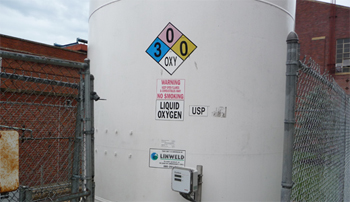About 7:30 a.m. today, a leak occurred in a liquid oxygen tank next to the campus Central Utility Plant that caused the ARS building, The Lied Transplant Center, Bennett Hall and the Specialty Services Building to be evacuated.
The leak was contained quickly and the all clear was given shortly before 8:30 a.m. No injuries were reported.
 |
A liquid oxygen leak occurred on campus this morning. The leak was contained within about 30 minutes and no injuries were reported. |
What is liquid oxygen?
It is a compressed form of pure oxygen that is extremely cold. It stores at about -377 degrees Fahrenheit. It is classified as an oxidizer and it supports combustion.
What is it used for at UNMC?
It provides oxygen for all the patients throughout the hospital. In spite of the leak – oxygen flow continued and caused no interruption of service to patient care. The system we have is used in every hospital in the city.
What caused this morning’s leak and how was it detected?
A crack occurred in a vaporizer, which caused the oxygen to leak from the tank. When liquid oxygen hits the air it vaporizes and creates a thick cloud. I’ve been here for 30 years and have never seen this. More oxygen is being brought on campus to alleviate any possible shortage.
How was it contained?
We closed the line to the vaporizer and diverted the liquid oxygen from the reserve tank. Linweld – the company that owns and maintains the oxygen tanks – has personnel on campus currently evaluating the cause of the leak and determining the best way to repair it. They will report back to us about what caused the leak, how they will repair the tank and how they will prevent future leaks.
Why were buildings evacuated?
They were evacuated because of potential fire risk due to the oxygen-rich environment. It was purely a precautionary measure. Traffic was diverted to prevent a passing car from being a potential source of fuel or ignition for a fire or explosion. That lightning was in the area also added to our concern. Normally the air we breathe is about 21 percent oxygen, in the area near the leak, the air was near 100 percent oxygen, which greatly increases fire risk.
Kudos to the communications on this incident, fantastic means of keeping the campus population informed.
Thanks for the quick updates from PR! Good to know just what happened. Additional kudos to campus security for directing traffic and evacuations.
I think it's great that UNMC Today jumped right on this and posted answers to the questions everyone was asking.
Good going, UNMC Today!
Actually, I have a question. I had heard a rumor that lightening struck the Liquid Oxygen tank, causing the leak. Just wondered where that got started, and what really did cause the crack in the vaporizer?
Facilities, management and planning officials say lightning DID NOT cause the crack in the vaporizer, which led to the liquid oxygen leak on campus this morning. Linweld — the company which owns and maintains the tanks — is examining the crack to see how it was caused but, again, officials are certain it was not caused by lightning.